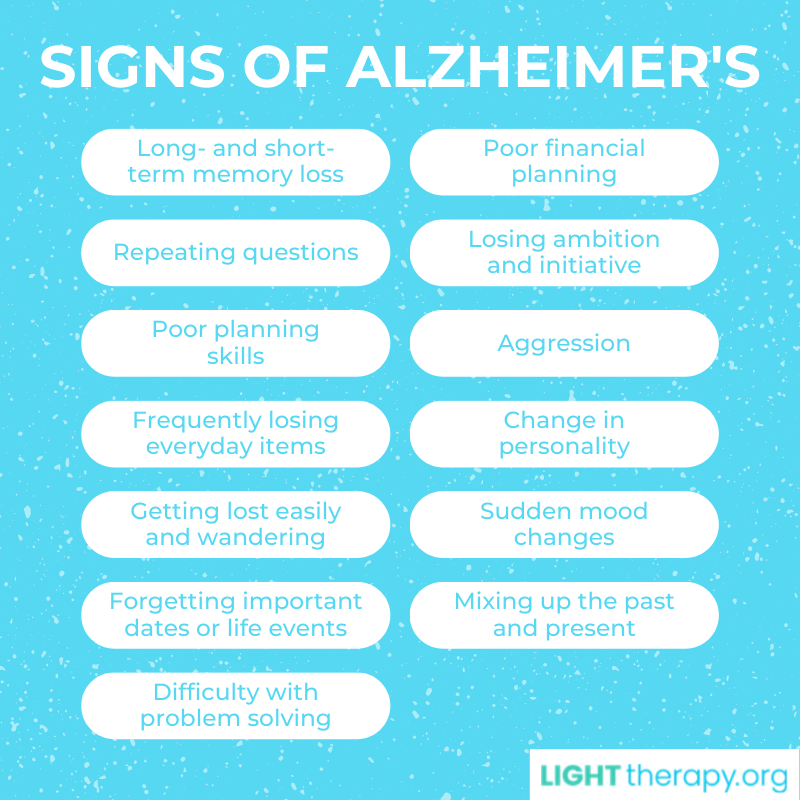How Light Therapy Is Developing to Help With Alzheimer’s
We cherish and adore our older loved ones. They’ve experienced rich, full lives and nurtured the next generation. Unfortunately, age is the top risk factor for many conditions, and seniors consequently deal with many difficult health problems. Of those, few diagnoses are more devastating than Alzheimer’s disease.
Characterized by severe memory loss, Alzheimer’s disease is a type of degenerative brain disorder, meaning it worsens over time. The Alzheimer’s Association estimates about 55 million people worldwide currently have dementia caused by either Alzheimer’s disease or another source.
If someone you love is suffering the brutal effects of Alzheimer’s, know that you’re not alone, and there is hope. New research is being done every day, including research into Alzheimer’s and light therapy.
What Is Light Therapy?
Before we explore Alzheimer’s and light therapy, let’s look at what light therapy is and how it can treat mental health conditions.
Light therapy involves exposure to select wavelengths of light, usually via devices using light-emitting diodes (LEDs). Thousands of peer-reviewed studies have shown that these wavelengths can produce a myriad of positive effects on the body, especially increased blood flow, reduced inflammation, and expedited recovery times.
Light Therapy for Mental Health
How can this powerful tool be put to use in the mental health field? Researchers and mental health practitioners are already on the case.
Light therapy is a proven treatment for mood disorders like bipolar disorder and multiple types of depression. This includes SAD, or seasonal affective disorder, a type of depression associated with the extended hours of darkness during the late fall and winter.
It’s believed that light therapy aids mental health in a few different ways. Light therapy boosts levels of serotonin, the neurotransmitter in the brain associated with mood. It’s sometimes called the “happy hormone,” and increased levels make us feel good, reducing the effects of anxiety and depression.
Light therapy also eases symptoms of SAD by regulating the sleep cycle. Exposure to light shortly after waking up stimulates the retinas, which connect to the hypothalamus, the part of the brain that controls sleep. Strategic use of bright light therapy helps reset the brain’s sleep rhythm to healthy intervals.
Finally, light therapy can also boost energy and feelings of alertness.
What Is Alzheimer’s Disease?
Unfortunately, Alzheimer’s disease doesn’t seem to be going anywhere. Here are a few other hallmarks of this terrible disease:
- Long- and short-term memory loss
- Repeating questions
- Poor planning skills
- Frequently losing everyday items
- Getting lost easily and wandering
- Forgetting important dates or life events
- Difficulty with problem solving
- Inability to handle money or poor financial planning
- Losing ambition and initiative
- Aggression
- Changes in personality
- Sudden mood changes
- Mixing up the past and present
- In later stages, hallucinations or inability to carry out simple tasks
The terms Alzheimer’s and dementia are often used interchangeably, but they have different meanings. While Alzheimer’s is a specific brain disorder, the term “dementia” describes a set of symptoms that stem from a variety of brain disorders, including Alzheimer’s. These symptoms typically affect older people and involve issues with memory, critical thinking skills, judgement, reasoning, concentration, and attention.
Alzheimer’s symptoms worsen over time, and there is no known cure — only treatment options, like light therapy.

Alzheimer’s and Light Therapy
Light therapy is not a cure for Alzheimer’s, but it treats certain aspects of the disease in a similar way to how it treats mental illnesses like depression.
Alzheimer’s patients and other people with symptoms of dementia often have a dysregulated sleep cycle, or circadian rhythm. Light therapy’s ability to regulate the sleep cycle can ease symptoms of sleep disturbance. One study from 2022 showed that bright light therapy, or BLT, reduces the “circadian abnormalities” often experienced by Alzheimer’s patients.
Another study from 2022 found that light therapy reduces inflammation, helps prevent further damage to neurons, the information messengers in the brain, and may reduce reactive oxygen species (ROS), a free radical that damages proteins, DNA, and RNA.
As of this writing, even more studies are underway.
Alzheimer’s and Light Therapy: Conclusion
Alzheimer’s and light therapy have some promising research behind them, but there is still work to be done. Larger studies would provide more information about how this treatment could help a larger portion of Alzheimer’s patients and their families.
Light therapy is a safe and generally side-effect-free treatment option, though treatment for mental health purposes should always be guided by a professional familiar with the therapy. Portable, at-home devices make light therapy a more affordable and convenient treatment option than ever before.
If you think light therapy might help you or a loved one deal with the debilitating effects of Alzheimer’s, dementia, or another mental health condition, speak to your healthcare professional about adding this modality to your treatment plan.